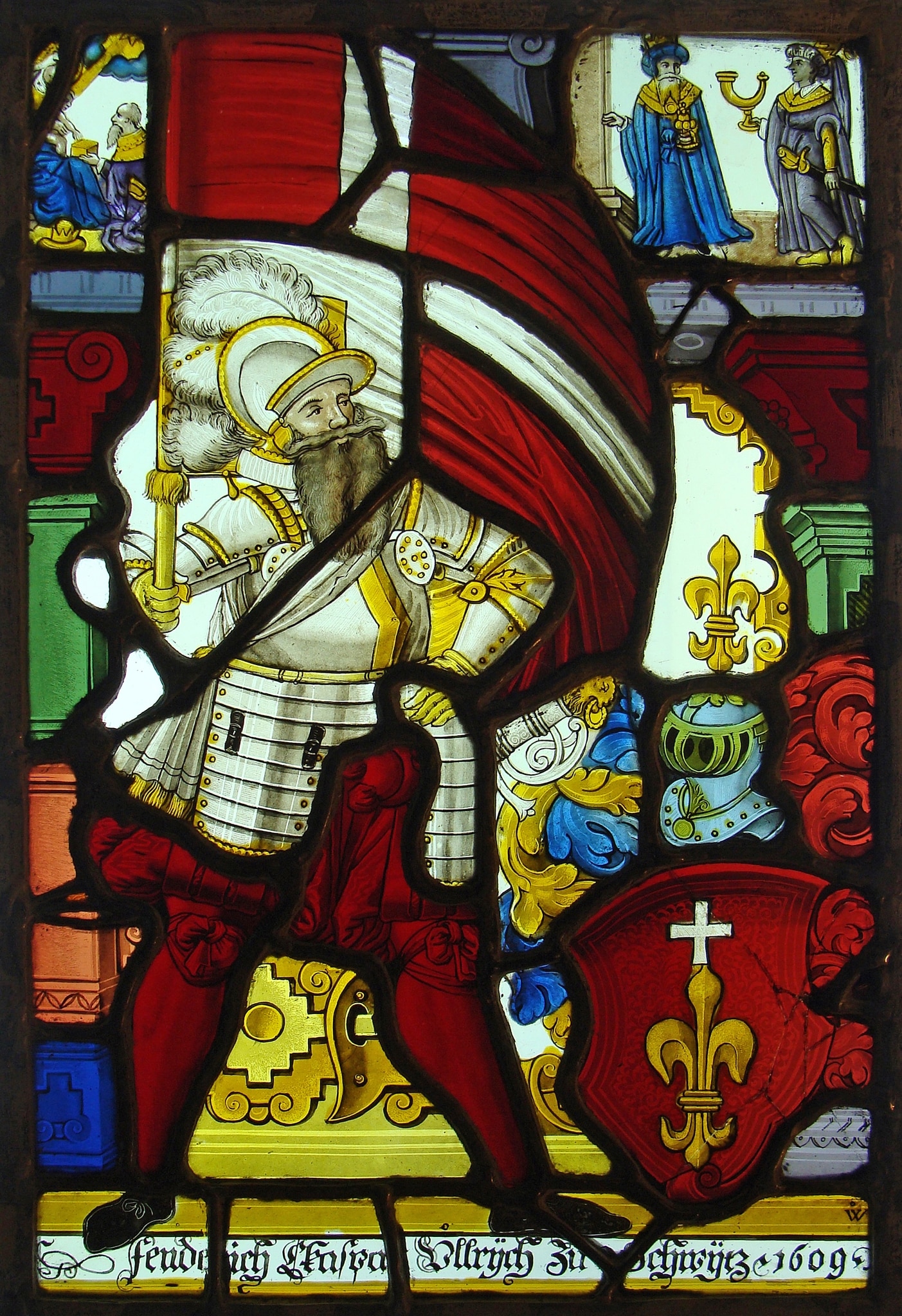The panel can be identified with Uli (Ulrich) Wüörner, an artist who was active in Schwyz as a glass painter from 1604 to 1611. In the sixteenth and seventeenth centuries the name “Uli/Ulrich” was written as V(o)lrich, with the little “o” set over the “V” as in the monogram of the panel. Carl Styger surveyed the records for glass painters in the canton of Schwyz, discovering a small number of panels for which Uli Wüörner was responsible. He was associated with Hans Wüörner whose documented work dates from 1593 through 1619 (Styger, 1885, pp. 8–10; Boesch, 1955, p. 37). Both Uta Bergmann and Rolf Hasler have suggested attribution to Uli. If this interpretation is correct, the Los Angeles panel is the only known work to bear Uli Wüörner’s signature.
A panel commissioned by Kaspar Brunner with an image of the Coronation of the Virgin (Hasler, 2010, pp. 328–29, cat. no. 127), although by an unidentified artist, shows similar clarity in the architectural elements and use of outline in the figures. The panel also exhibits similar rounded figural types and softness in the modeling of the faces and bodies. The composition employed in the Los Angeles panel appears in slightly earlier panel commissioned in 1603 by Ulrich Stucky of Glarus (Hasler, 2010, p. 333, cat. no. 132). The format of armored figure, shield to the right, crowned by helm and mantling, and the proportional relationship of architecture, figure, shield, upper scene, and inscription panel is similar; however, the handling of the paint is tighter, with less variation. A third panel with similar characteristics shows Christian Iten and Anna Etter, with the date inscription of 1606, also presents a standard-bearer with a magnificently unfurled flag (Bergmann, 2004, pp. 253–54, no. 67). Scholars suggest the location of its manufacture as Zug or Schwyz, where Wüörner worked. The deep horizontal folds of the banner and the effortless stance of the man holding the staff resonate with the figure in the Los Angeles work. Both panels display the same interest in sharp outline.
Kaspar Ulrich proudly represents himself as the standard-bearer holding the red and white banner of Schwyz. The town of Schwyz, recorded in 972 and set in central Switzerland about thirty-five miles south of Zurich, later extended its name to the canton formed around it. It remains of historical importance far beyond its size since it was one of the three Forest Cantons, along with Uri and Nidwalden to form the Confederation Helvetica in 1291. It ultimately provided the name of Switzerland for a country formed of multiple independent Cantons. The depiction of the Three Magi is clearly a personal choice by Ulrich, living in a city that had remained staunchly Catholic. Ulrich’s first name is Kaspar, and the imagery gives a special emphasis to Caspar, traditionally the third and youngest of the Three Magi. He stands directly above the arms of Ulrich. The Magi were highly venerated in Germanic custom since their relics were believed to be preserved in the cathedral of Cologne. On the left King Balthasar kneels before the Virgin and Child, and to the right Melchior turns towards Caspar who alone is profiled with a sword. Caspar is shown with darker skin, defining his origins as African, a tradition in European art since the late Middle Ages. He bears frankincense, proclaiming the divinity of Christ. His great curving horn is silhouetted against the background, its shape similar to that carried by the supporting figure of Caspar in the panel given by Kaspar Pfyffer (Los Angeles County Museum of Art, 45.21.42, US_27).
Cited in:
LACMA Quarterly, 1945, pp. 5–10.
Normile, 1946, pp. 43–44.
Hayward, 1989, p. 73.
Raguin, 2024, vol. 1, pp. 185–88.
